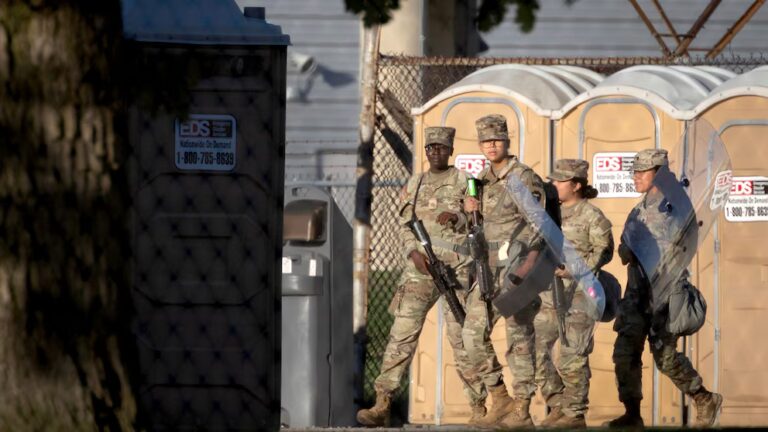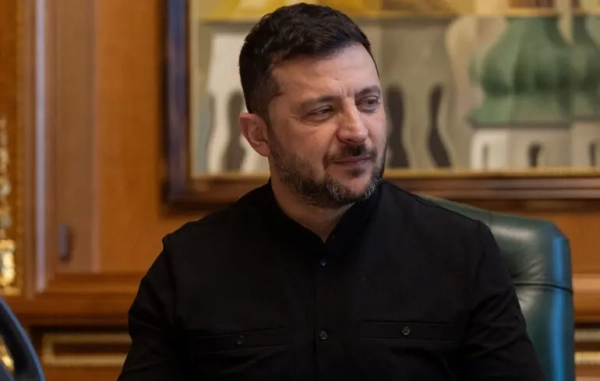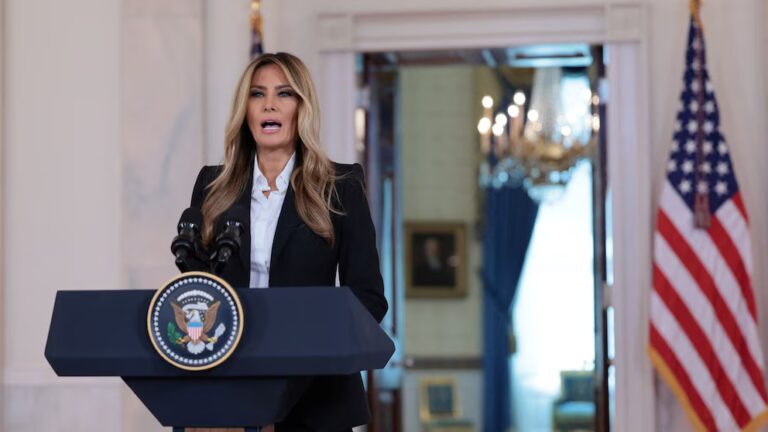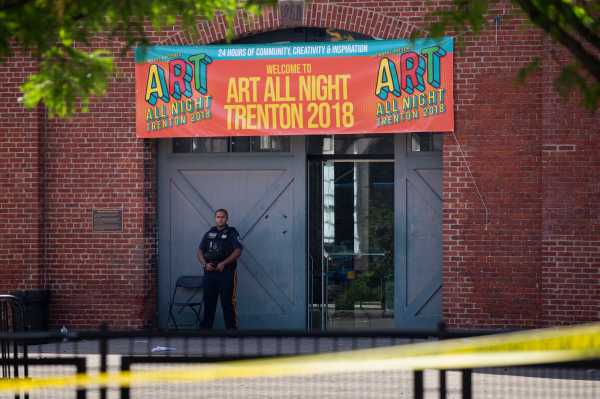
Twenty-two people were injured and one person was killed during a mass shooting at an art fair in Trenton, New Jersey, over the weekend.
The incident wasn’t what many Americans imagine as a typical mass shooting, in which a lone gunman fires indiscriminately into a crowd. Instead, it seems to have been a gang-related shootout between multiple gunmen.
According to Luis Ferré-Sadurní and Mihir Zaveri at the New York Times, the shooters fired at each other at the 24-hour Art All Night festival shortly before 3 am — wounding 17 with gunfire and causing a stampede that injured five more.
The person killed, 32-year-old Tahaij Wells, was reportedly one of the gunmen and was killed by police. Another shooter was hospitalized, and yet another was arrested.
There were multiple physical altercations at and around the fair prior to the shooting, leading police to try to disperse the area. But some people remained until late in the night.
Under some definitions of a mass shooting, this incident actually wouldn’t count as one. In some cases, analysts, like Mother Jones, exclude gang-related events from their counts of mass shootings because they’re trying to capture what Americans traditionally think of as a mass shooting. Other definitions do count gang-related events but still wouldn’t include the Trenton shooting because not enough people were killed to meet the definition.
Under the definition Vox uses (also used by the Gun Violence Archive), the event would qualify as a mass shooting — since four or more people were shot, even if they weren’t killed.
Regardless of how one defines it, this kind of shooting deserves public attention. While the Trenton shooting was particularly bad, it’s representative of the kind of everyday gun violence that occurs in the US — and helps make America far and away the developed world’s leader in gun deaths. That’s perhaps why the Trenton shooting hasn’t gotten as much attention or media coverage as other mass shootings; it seems too typical in some ways. But it’s also exactly why Trenton should get more attention.
The typical gun violence we often ignore
In 2016 (the latest year for which data is available), there were nearly 39,000 gun deaths in the US. More than 14,000 of those were homicides, and almost 23,000 were suicides. Using Mother Jones’s definition of a mass shooting, 71 deaths in 2016 were due to mass shootings. That represents less than 1 percent of all gun deaths that year.
Based on what we know so far, the Trenton shooting is representative of much of the remaining 99-plus percent.
Several of the victims in Trenton, including the gunman who was killed, were black. This, too, is common: In 2016, for example, more than 52 percent of murder victims (73 percent of whom were killed by guns) were black, even though black people only make up about 13 percent of the general population.
The racial breakdown may help explain the lack of national attention to more typical gun violence. We know that racial biases make white Americans more likely to perceive black people as less innocent and even as criminals, which may, in some people’s minds, make these victims more deserving of the gun violence in their communities.
Even though these more typical shootings rarely come up in the national debate about gun control, the evidence is actually strongest for stricter gun laws preventing the more common shootings, including suicides. In fact, the empirical evidence is weaker for the effect of gun control on the mass shootings that do draw national attention — largely because these tragedies are relatively rare and therefore more difficult to study.
A recent review of US-based studies by the RAND Corporation, for example, found no good evidence of gun-related policies affecting mass shootings, deeming the studies in this area “inconclusive.” But RAND did find evidence that some measures — background checks, child access prevention laws, minimum age requirements, and prohibitions associated with mental illness — are all together linked to reductions in injuries and deaths, including more typical gun homicides and suicides.
The RAND review’s conclusions are backed by other research. A 2016 review of 130 studies in 10 countries, published in Epidemiologic Reviews, found that new legal restrictions on owning and purchasing guns tended to be followed by a drop in gun violence — a strong indicator that restricting access to firearms can save lives. But those findings were for gun deaths broadly, with mass shootings rarely being the focus of the analyzed studies.
One could still infer from this evidence that stricter gun laws will reduce mass shooting deaths, but it’s an inference from the data, not a strong empirical finding. Meanwhile, the research indicates that stricter gun laws really could help prevent more shootings like that in Trenton over the weekend — even though gun control is rarely brought up nationally after such events.
There are also some evidence-based policies that could help reduce everyday gun violence outside the realm of gun control, including more stringent regulations and taxes on alcohol, changes in policing, and behavioral intervention programs. These, too, rarely get national attention after a shooting like Trenton’s.
But perhaps they should. Despite a drop in crime and violence overall since the 1990s, the US still leads the developed world in terms of gun deaths.
America’s unique gun violence problem
The US has nearly six times the gun homicide rate of Canada, more than seven times that of Sweden, and nearly 16 times that of Germany, according to United Nations data compiled by the Guardian. (These gun deaths are a big reason America has a much higher overall homicide rate, which includes non-gun deaths, than other developed nations.)
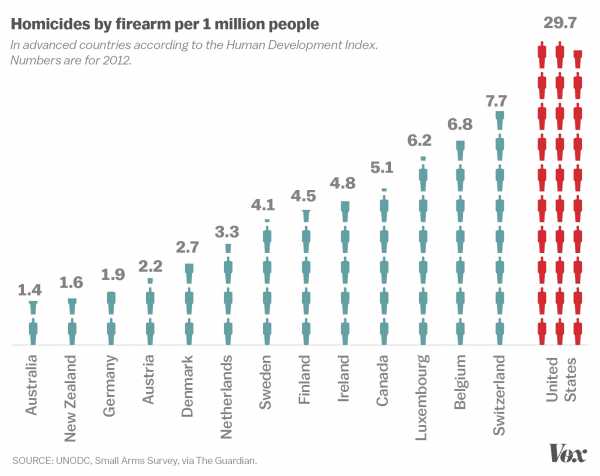
So why is the US such an outlier? Researchers widely believe it’s due to America’s tremendous abundance of and access to guns. According to estimates, in 2007 the number of civilian-owned firearms in the US was 88.8 guns per 100 people, meaning there was almost one privately owned gun per American and more than one per American adult. The world’s second-ranked country was Yemen, a quasi-failed state torn by civil war, where there were 54.8 guns per 100 people.
The research, compiled by the Harvard School of Public Health’s Injury Control Research Center, is clear: After controlling for variables such as socioeconomic factors and other crime, places with more guns have more gun deaths. Researchers have found this to be true not just with homicides but also with suicides (which in recent years accounted for around 60 percent of US gun deaths), domestic violence, and even violence against police.
As a breakthrough analysis by UC Berkeley’s Franklin Zimring and Gordon Hawkins in the 1990s found, it’s not even that the US has more crime than other developed countries. This chart, based on data from Jeffrey Swanson at Duke University, shows that the US is not an outlier when it comes to overall crime:
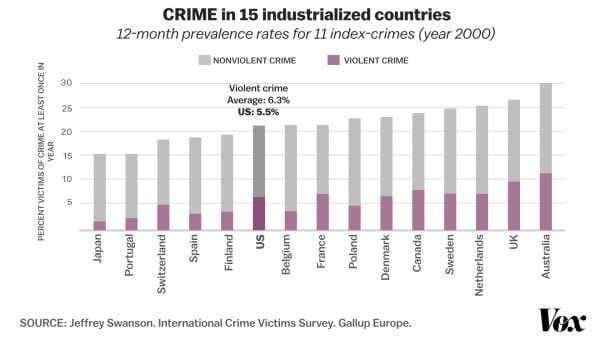
Instead, the US appears to have more lethal violence — and that’s driven in large part by the prevalence of guns.
”A series of specific comparisons of the death rates from property crime and assault in New York City and London show how enormous differences in death risk can be explained even while general patterns are similar,” Zimring and Hawkins wrote. “A preference for crimes of personal force and the willingness and ability to use guns in robbery make similar levels of property crime 54 times as deadly in New York City as in London.”
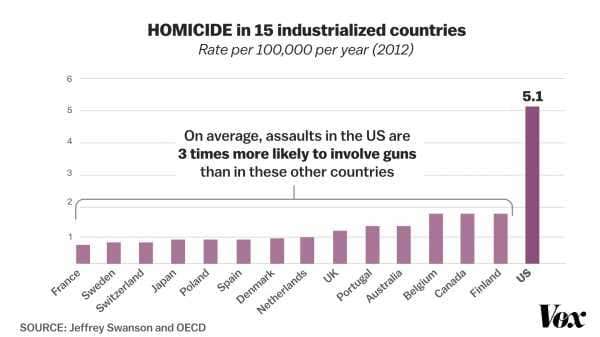
This is in many ways intuitive: People of every country get into arguments and fights with friends, family, and peers. But in the US, it’s much more likely that someone will get angry at an argument and be able to pull out a gun and kill someone.
That’s why, based on the research, gun control measures could help — by making it harder for someone to have and pull out a gun in the first place.
But the US maintains some of the weakest gun laws in the developed world. Until America confronts that issue, it will continue seeing more shootings than its developed peers.
For more on America’s gun problem, read Vox’s explainer.
Sourse: vox.com
